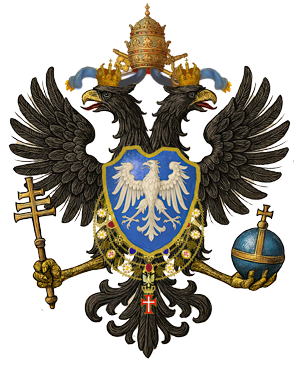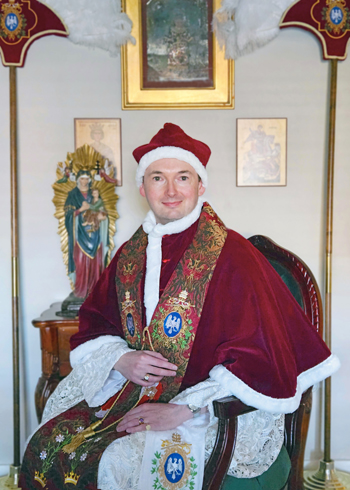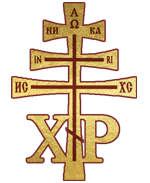|

Fides Petraque
Apostolic Constitution of His Apostolic Highness Radislav I, Roman-Ruthenian Pope
on the Continuity of the Holy Apostolic See and the Providence of God

21 May 2025

Приветствие и наше апостольское благословение!
“The Lord is my portion, saith my soul: therefore will I wait for Him.” Lamentations 3:24
I. The Time of Trial
Faith is a rock of
truth. Yet, in these years of darkness and disarray, when truth has
been eclipsed by confusion, when schism has cloaked itself in liturgy
and heresy in the language of love, the visible structure of the Church
has been grievously wounded. Rome, the Eternal City, has been occupied
not by strangers, but by those who once bore the name of sons.
Nevertheless, “a still small voice” (1 Kings 19:12) calls to the
faithful.
II. The Succession in Fidelity
On the 21st day of
April, anniversary of the founding of Rome, We, Radislav, a descendant
of Holy Rus’ to which We are now heir, were received into full
communion with the Holy See of Peter in Rome. On that same day, 23
years later, the Roman Pope died. We had been named in 2014 Coadjutor
of Rome by the Cardinal Dean and given full papal authority in Our
jurisdiction, i.e., what is now the United Roman-Ruthenian Church.
Notably, the feast day of Our patron saint, Blessed George the
Protomartyr and Bringer of Victory, falls on the 23rd of the same
month. George, a military saint, but not merely of arms — a
dragon-slayer, a witness unto death, a man of pure, Christ-centered
courage. He is venerated in Russia, England, Greece, Syria, Lebanon,
Ethiopia — a truly universal saint, uniting East and West. His icon
slaying the dragon is a sign of Christ's victory over the devil, and by
extension, of the Church's victory over falsehood, tyranny, and
apostasy. This is the Church Triumphant whispering to the Church
Militant.
Upon the death of the
Roman Pope, the fullness and completion of what had been entrusted to
Us came to fruition. Indeed, it is the mission to preserve the unity
and continuity of the Holy Orthodox and Catholic Church, to which the
Roman-Ruthenian Church is rightful and faithful successor; for We were
named Coadjutor with right of succession, appointed and confirmed by
word in document. It is a prophetic sign of divine continuity, a new
Peter rising from the East, a re-anointing of the true Rome through
fidelity and suffering. The Church, clasping sinners to her bosom, at
once holy and always in need of purification, follows constantly the
path of penance and renewal. (Lumen Gentium, 8)
It should also be
remembered also that Our chrismation, many years before, in the
traditional Anglican Rite, occurred on the 5th of August — the feast of
the dedication of the Basilica of Saint Mary Major, the same basilica
in which Pope Francis of Rome chose to be buried. It was from this
basilica that the Western Church first proclaimed Mary as Theotokos
after the Council of Ephesus. The First and Second Rome may fall, but
the Mother remains — and the Spirit anoints the one she has chosen.
Thus, from the Mother of God We were anointed, and to her We now
entrust Our continued pontificate in its fullness.
“All things work together for good for those who love God.” Romans 8:28
“In the fullness of time, God sent His Son.” Galatians 4:4
This is no coincidence. It is providence, not
planning, for the Church reads the signs of the times in the light of
the Gospel. (Gaudium et Spes, 4)
III. The Nature of the Papacy
The Ministry of Peter
is not dependent upon marble, nor building in Rome, nor temporal
sovereignty, nor the favor of emperors or media. It is a spiritual
office, divinely instituted by Christ (cf. Matthew 16:18), exercised in
service to unity and truth.
Canon law is sacred,
yet it remains the servant of divine law, not its master. When the
ordinary mechanisms for a legitimate, non-heretical papal election
become impossible, provision may be made by the Pope or by legates duly
authorized by him—for the Petrine office is founded not upon the will
of men, but upon the Word of the Lord who said: ‘I have prayed for
thee, that thy faith fail not.’ (Luke 22:32)
“Since to great Peter Christ our Lord gave the
office of Chief Shepherd after entrusting him with the keys of the
Kingdom of Heaven, to Peter or his successor must of necessity every
novelty in the Catholic Church be referred.” St. Theodore the Studite, Letter to Pope Leo III
IV. The United Roman-Ruthenian Church as the True Successor
Now, We and our
bishops, validly consecrated, Orthodox in doctrine, and all of us
together, the faithful and the clergy of the Roman-Ruthenian Church and
State, have by declaration of Rome become the true Successor of Peter.
We hold this not by election, but by designation, with the full moral,
theological, and sacramental justification. We are not bound to Roman
marble, but to the office, to the succession, and to fidelity.
We, the
Roman-Ruthenian Church and State, hold this even when there may be an
occupying Church, modernist, powerful, apostate; who claims Our right
and authority. Yet the Church becomes once more Apostolic not only in
name, but in form: and whether or not it be wandering, or poor, or
hated by the world, it nevertheless bears the marks of Christ.
“We are made as the refuse of this world, the offscouring of all, even until now.” 1 Corinthians 4:13
The primacy of Peter is not geographical—it is personal and institutional (Pastor Aeternus, First Vatican Council).
The essence of the papacy is to preserve unity and Orthodoxy, not to
possess property. The material visibility of the Church can be obscured
temporarily, but her spiritual reality never disappears (Lumen Gentium, 8).
In times of great crisis, extraordinary actions are not innovation but
preservation. And thus, Our Holy Apostolic See, by its right of
succession and its preservation of Orthodoxy, is the true visible head
of all Latin Christians, in addition to all others under her sacred
mantle of care. And in so doing, we have returned the core of the Latin
Church to true and authentic Orthodoxy.
Furthermore, here the
ecclesiastical body commonly known as the Vatican Church—equated with
the modern Roman Catholic Church—must be acknowledged as a distinct and
separate entity. While it retains certain external forms of tradition,
it has, in substance, embraced innovations and theological developments
incompatible with the Apostolic deposit of the Orthodox and Catholic
faith. We refer to its pontiff as the Roman Pope in fraternal charity,
but not as a recognition of doctrinal or canonical supremacy. Nor do We
contest its use of the title "Bishop of Rome," for We do not claim that
diocesan office ourselves. Rather, We affirm that the visible primacy
of the Latin Orthodox tradition has, by divine providence and
ecclesiastical necessity, passed in spirit and function to the United
Roman-Ruthenian Church — which alone among the Apostolic Churches
preserves the Latin patrimony free from the distortions of modernism.
Our purpose is not rivalry, but fidelity; not to supplant, but to
preserve and to heal.
And yet, the United
Roman-Ruthenian Church is not a Latin Church in disguise, nor a revival
of Roman centralism, but rather the providential continuation of Rome’s
mission through Holy Rus’. It is an Eastern Roman Church with Latin
heritage, rooted in the Orthodox soul of Ruthenia (Old Russia), bearing
the spiritual patrimony of both Latin and Byzantine tradition, the
Slavic legacy, and the inheritance of the undivided Church. Our
apostolic mission is the integration of Eastern and Western heritage
into the Orthodox fullness — not by syncretism, but by harmony — in the
spirit of the ancient Pentarchy and conciliarity. Rome, in this sense,
has found its renewal under Rome-Ruthenia, not by conquest or politics,
but by providential realignment in truth. Indeed, the One, Holy,
Apostolic, Orthodox, and Catholic Church is the one, indivisible Church
of Christ, not by works of men, but solely because, by the grace of God
expressed in the Passion of Christ, in the blood of the martyrs, and in
the witness of the saints, the Church has preserved to this day this,
its God-given mission.
V. To the Faithful
We speak now not
merely to the powerful, but to all the faithful, to the clergy and
faithful who still proclaim the Creed in a world that has forgotten how
to kneel before God, who still maintain and profess the Orthodox faith.
You are not alone. The Church is not dead. Whether we be many, and
whether we be joined or scattered, we are the true Church.
VI. A Call to Faith
To those clergy who
are not corrupted, but Orthodox, We say keep the faith. To bishops who
know the truth, have the courage to act in justice. To all
Churches, wounded by schism, yet noble in faith, let us join together,
not in submission, but in fulfillment. To all the faithful: hold
fast, teach your children, confess the truth. Do not follow the false
teachings of the era, but stay with the timeless faith of
Christ. Together this, with the blood of the
martyrs and the power of the confessors, is the seed of this new spring.
VII. Conclusion
Let us remember that
Orthodoxy is truth: truth handed down, preserved, and lived. And the
truth does not cease to be true because some will not accept it. (St. John of Damascus)
“To be Orthodox means to have the God-man Christ constantly in your
soul, to live in Him, think in Him, feel in Him, act in Him.” St. Justin Popovichф
From the East, in Holy Rus', Peter has risen
again — not in personal glory, but in the glory of Christ. We do not
claim perfection. We claim only what was given to Us: the keys, the
cross, and the promise that the gates of hell shall not prevail.
|